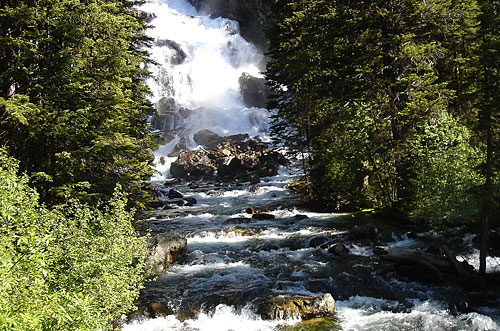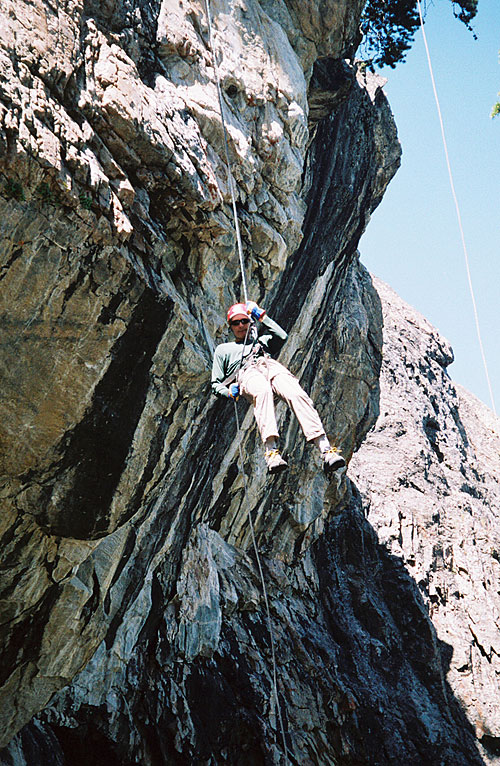
|
Hidden Falls is one of the Tetons' most beautiful and serene spots. Wednesday, July 6 Harry Wallfisch says that rock climbing is a lot like anesthesiology. “It's big blocks of time that are sheer tedium interspersed with short periods of stark terror.” We met Christian and Mark at the Exum headquarters at 7:45 a.m. on Wednesday. First, we traded in our boots for Cindercone climbing shoes by Nike. We ferried across the beautiful Jenny Lake. From the dock, we hiked back into the foothills of the Tetons. We passed Hidden Falls, a roaring fall of water that feeds Jenny Lake. Near the falls, we stopped and spent an hour gearing up. The gear includes helmets, harnesses, ropes, carabiners, cams, chocks and other equipment. Climbing a rock face involves seeking footholds and hand holds as you move up. Footholds, we found, were more important than those for hands. If you depend too heavily on moving with hand and arm strength, you're doing something wrong, and you can't do it for long.
The guides went up first, setting belaying positions above. Then the rest of us roped up and followed them up. At each pitch, we got a chance to belay the man below, often doing it wrong. The most common mistake was a lapse in concentration and releasing the brake hand with the man below still climbing and in a position to fall. “No!” Christian would say forcefully. “You cannot let go with your brake hand. Never.” Climbers use very specific signals between the climber and the belay man. If you're preparing to climb and the rope from above grows taut, you say, “That's me, Harry.” From above, Harry steadies his belay position, then calls out, “Climb, Dolph.” It is important to use the names because when climbing in groups, it's easy to confuse commands with another nearby group of climbers. While climbing, you must climb and think, looking constantly for holds, strategizing as you go. Sometimes you must use your body as a bridge, using counter pressure to balance your weight between two lateral points while seeking a next hold. Sometimes you must use your feet to “smear,” reaching across an open expanse of rock to find what amounts to no more than a rough spot for purchase and a boost up. We ended on a plateau above the rock faces we'd been climbing that morning. We ate lunch and rested and then moved to a sheer cliff to practice rappelling. I asked to go first, and Christian secured the rappel rope to my harness. “Go, man,” he said. I swallowed hard, turned my back to the void and walked off - backwards. It was a blast. After rappelling twice, we moved on to another rock climb, this one called the Bat's Wing. It was more difficult and after five tough pitches we were at the top. We walked down and passed our starting point. Looking back up, each of us thought the same thing: I can't believe we climbed that. At the end of that day, Mark and Christian suggested we climb to Cube Point the next day. |
By Dolph Tillotson
Climbing Teton
1 - Just Have Fun
2 - The Climbers
3 - Tuesday
4 - Wednesday
5 - Thursday
6 - Friday
7 - Summit Day 8 - Time is Short The relationships are more important than the climb. Resources See also |
© 2005 The Galveston County Daily News. All rights reserved. A Galveston Newspapers Inc. Publication. |


